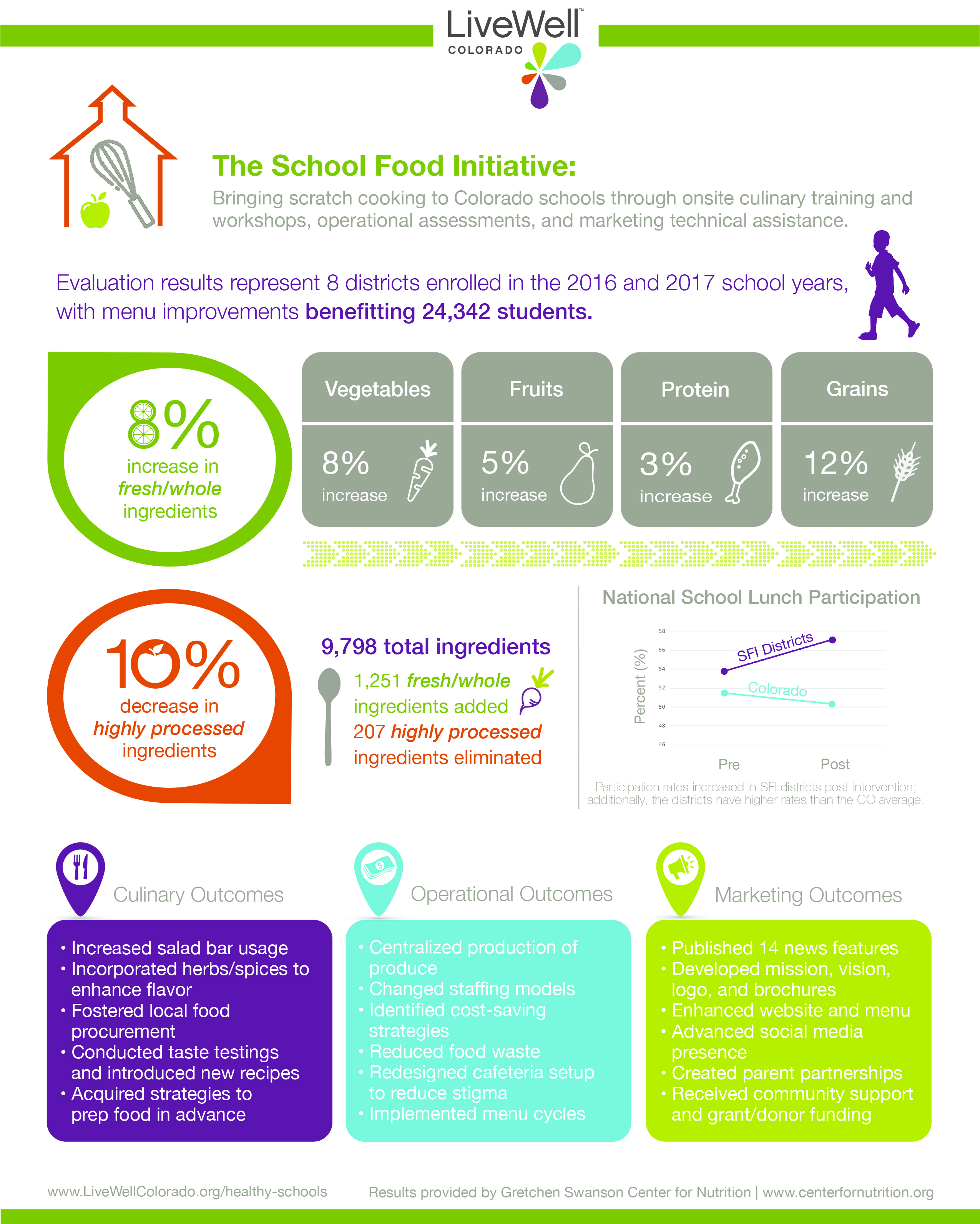New Infographic Illustrates Impact of School Food Initiative
*See detailed summary explanation of infographic in narrative below.
SFI Infographic Summary
LiveWell Colorado’s School Food Initiative (SFI) is a 2 year program providing culinary, operations, and marketing technical assistance to Food & Nutrition Service Departments in school districts across Colorado, one cohort at a time. Since its inception in 2010, the SFI has partnered with 100 districts, improving meals in 1,570 individual schools for 767,419 students. The SFI kicks off with a group workshop, and then delves into on-site, hands-on training with SFI Chefs on the proper application and introduction of fresh/whole ingredients into district menu cycles. Coupled with operations and marketing assistance, districts are supported in the creation of lasting change in their respective kitchens.
This infographic represents evaluation results for the 8 districts that participated in the SFI during the 2016/2017 and 2017/2018 school years. All evaluation activities were conducted at pre- and post-intervention. Activities included measuring the use of fresh/whole, transitional/clean label, and highly processed ingredients across a 4-6 week menu cycle using the Quantitative Menu Analysis (QMA) technique, as well as conducting interviews with key Nutrition Services staff to gather information about district successes and challenges.
A total of 9,798 total ingredients were scored during the QMA process. Results show that the use of fresh/whole ingredients across districts at pre-assessment averaged 58% of total ingredients used, while at post, the use of fresh/whole ingredients across districts averaged 66% of total ingredients used. This indicates an 8% increase in the use of fresh/whole ingredients during the intervention period. This increase occurred as a result of 1,251 more fresh/whole ingredients being incorporated in menu cycles at post-assessment. Additionally, the use of highly processed ingredients decreased by 10% during the intervention period, averaging 26% at pre and 16% at post. Overall, 207 highly processed ingredients were eliminated across the districts. The use of fresh/whole ingredients was also examined at the component (food group) level; results show an increase in the percentage of fresh/whole ingredients by component at post. For example, across all vegetables used in the menu cycles at pre, 76% were fresh/whole, while at post, 84% of all vegetables used were fresh/whole for a total increase of 8%. Proteins (animal-, plant-, and dairy-based) increased by 3%, fruits by 5%, and grains by 12%.
Culinary, operational, and marketing successes were observed and collected across all districts. These included:
- Increasing salad bar usage to provide greater access to a larger variety of fresh fruits and vegetables.
- Incorporating more fresh and dried herbs & spices into scratch cooking practices to increase flavor and reduce sodium.
- Utilizing time management strategies to prepare large batches of ingredients in advance to facilitate scratch cooking.
- Examining meals per labor hour in order to make data-driven decisions on new staffing models.
- Determining ways to use leftover ingredients in future menu items, overall eliminating waste and saving money.
- Building 4-6 week menu cycles contributing to more efficient ordering, staff that are more confident in their ability to prepare menu items, and overall improved meal consistency across all district sites.
- Promoting successes in 14 media stories featured in district, statewide and national news outlets.
- Developing new outreach strategies through updated websites, hard copy materials, and social media.
- Gaining community support through meal program promotion & awareness, leading to new funding opportunities.
These eight participating districts made great improvements to student meals served under the National School Lunch Program. Enrollment for these 8 districts estimates that approximately 24,342 students benefit from the improvements in the nutritional quality of school lunch during the last school year.
The evaluation also assessed changes in average lunch participation in each district. Although a school district’s overarching goal is to increase lunch participation and department revenue in order to produce high quality meals with skilled staff, when significant culinary changes are being made, goals are typically more conservative. As menu quality is improving and potentially popular highly processed items are being eliminated, maintaining steady lunch participation without any significant decline is the desired outcome. However, analyses of lunch participation over time in these 8 districts indicated that healthy changes to the menu cycle did not negatively impact lunch participation; in fact, these districts experienced an increase over time (53.8% to 57.1%). The evaluation then compared lunch participation for the 8 districts to lunch participation in all Colorado public school districts during the same time frame. This comparison shows that the SFI intervention districts have a higher participation rate than the Colorado average.
LiveWell Colorado would like to acknowledge the hard work of the outstanding Food & Nutrition Service staff in this cohort!


